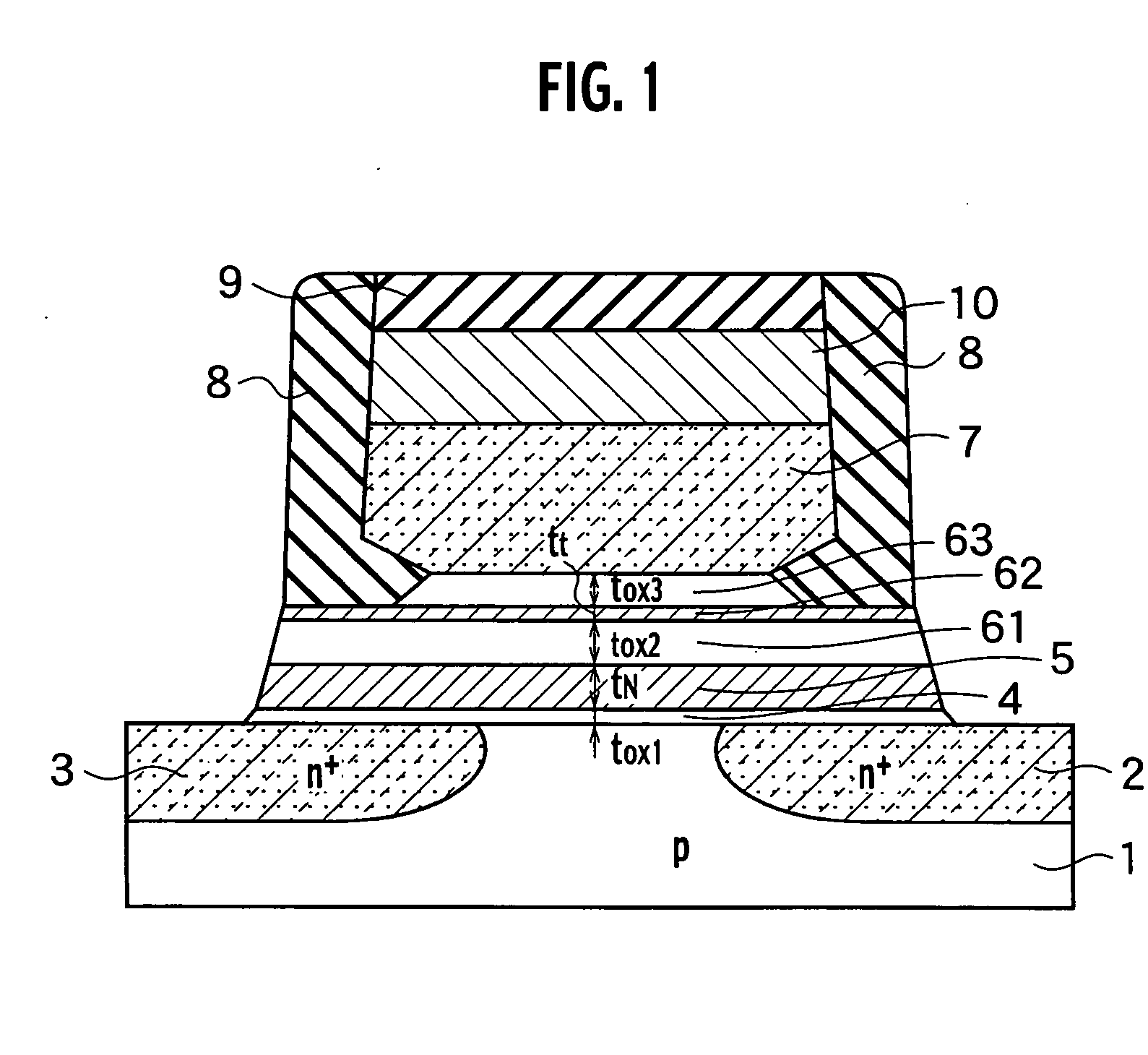Semiconductor memory
a technology of semiconductors and memory, applied in the field of semiconductor memory, can solve the problems of insufficient reduction, insufficient scalability, and difficulty in securing the isolation of the programming threshold voltage and the erasure threshold voltag
- Summary
- Abstract
- Description
- Claims
- Application Information
AI Technical Summary
Benefits of technology
Problems solved by technology
Method used
Image
Examples
first embodiment
(First Embodiment)
FIG. 1 shows an exemplary structure of a semiconductor memory according to the first embodiment of the present invention. The structure of this embodiment has a feature that, in comparison with a conventional example, has a second charge storage layer 62, for storing negative charges injected from a gate and is arranged in a portion of a second insulating layer corresponding to reference numeral 6 in FIG. 3. In FIG. 1, a first gate insulating layer 4, which is, for example, made from a silicon oxide film or an oxynitride film having a thickness of 0.5 nm to 10 nm, is formed on a p-type silicon semiconductor region 1 where the boron or indium impurity concentration is between 1014 cm−3 and 1019 cm−3, for example. In this case, tox1 denotes the thickness of the flat portion of the first gate insulating layer 4, and εox1 denotes a dielectric constant of the first gate insulating film. In addition, a first charge storage layer 5 having a thickness of 3 nm to 20 nm, whi...
second embodiment
(Second Embodiment)
As shown in FIG. 8, a semiconductor memory according to the second embodiment of the present invention, a control line, which is connected to a control electrode 7, is formed in the same direction as a source region 2, a p-type silicon semiconductor region 1, and a drain region 3 are formed relative to the first embodiment. It should be noted that detailed description for the same configurations as with the first embodiment using the same reference numerals is omitted.
The semiconductor memory according to the second embodiment of the present invention differs from the first embodiment in that a device isolating and insulating layer 12, made from a silicon oxide film, for example, is formed in a self-aligned manner on the source region 2 and the drain region 3. The second embodiment has a feature that, in comparison with the conventional example, a second charge storage layer 62, for storing negative charges injected from a gate and is arranged in a portion of t...
third embodiment
(Third Embodiment)
FIG. 11 shows an exemplary cross sectional structure of a semiconductor memory according to the third embodiment of the present invention. It should be noted that detailed description for the same portions as with the first embodiment and second embodiment using the same reference numerals is omitted.
The semiconductor memory according to the third embodiment of the present invention replaces an insulating layer doped with an accepter impurity for a second charge storage layer 62. The semiconductor memory according to the third embodiment of the present invention has a feature that, in comparison with the conventional example, has a second charge storage layer 62a for storing negative charges by doping the portion corresponding to the second charge storage layer 62 with an acceptor impurity. In FIG. 11, a first gate insulating layer 4, for example, made from a silicon oxide film or an oxynitride film having a thickness of 0.5 nm to 10 nm, is formed on the p-type s...
PUM
 Login to View More
Login to View More Abstract
Description
Claims
Application Information
 Login to View More
Login to View More - R&D
- Intellectual Property
- Life Sciences
- Materials
- Tech Scout
- Unparalleled Data Quality
- Higher Quality Content
- 60% Fewer Hallucinations
Browse by: Latest US Patents, China's latest patents, Technical Efficacy Thesaurus, Application Domain, Technology Topic, Popular Technical Reports.
© 2025 PatSnap. All rights reserved.Legal|Privacy policy|Modern Slavery Act Transparency Statement|Sitemap|About US| Contact US: help@patsnap.com



